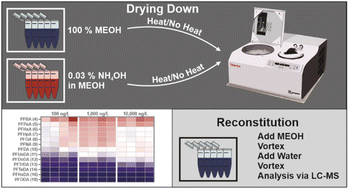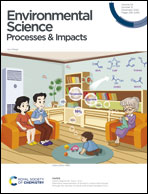Recovery of per- and polyfluoroalkyl substances after solvent evaporation†
Abstract
Per- and polyfluoroalkyl substances (PFAS) are persistent, bioaccumulative chemicals that can be toxic at very low levels. Many of these compounds have unusual chemical properties that can have a large impact on analytical methods intended to quantitate them. When analyzing environmental samples, concentrating extraction eluents can greatly increase the sensitivity of PFAS extraction and analysis workflows. However, data on PFAS stability when evaporated under vacuum drying conditions are lacking. In this study two common sample preparation methods were replicated (methanol or methanolic ammonium hydroxide) to determine if PFAS material would undergo any observable loss during vacuum evaporation. Standards containing 49 different analytes from 7 different PFAS classes were evaporated to dryness under vacuum either with or without heat and reconstituted using one of two methods. It was found that recovery of some classes (e.g. PFSA, PFESA, FTS) was not greatly impacted by evaporation conditions or reconstitution method. Some analytes such as the very long chain PFCAs were not affected by evaporation conditions but saw drastic differences in recovery depending on the reconstitution method. Others analytes, for example PFSAms, experienced significant loss during evaporation that could not be mitigated by the chosen reconstitution method. This difference could be due to the number of fluorines present on the compound which correlated with a compound's hydrophobicity. Due to these findings, it is recommend that researchers consider PFAS class, chain length, and fluorine number when designing concentration and reconstitution protocols for PFAS to ensure conditions are optimal for the specific analytes of interest.



 Please wait while we load your content...
Please wait while we load your content...